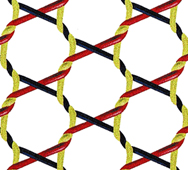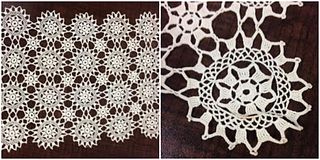
Tatting is a technique for handcrafting a particularly durable lace from a series of knots and loops. Tatting can be used to make lace edging as well as doilies, collars, accessories such as earrings, necklaces, waist beads, and other decorative pieces. The lace is formed by a pattern of rings and chains formed from a series of cow hitch or half-hitch knots, called double stitches, over a core thread. Gaps can be left between the stitches to form picots, which are used for practical construction as well as decorative effect.

Lace is a delicate fabric made of yarn or thread in an open weblike pattern, made by machine or by hand. Generally, lace is split into two main categories, needlelace and bobbin lace, although there are other types of lace, such as knitted or crocheted lace. Other laces such as these are considered as a category of their specific craft. Knitted lace, therefore, is an example of knitting. This article considers both needle lace and bobbin lace.

Bobbin lace is a lace textile made by braiding and twisting lengths of thread, which are wound on bobbins to manage them. As the work progresses, the weaving is held in place with pins set in a lace pillow, the placement of the pins usually determined by a pattern or pricking pinned on the pillow.

Chantilly lace is a handmade bobbin lace named after the city of Chantilly, France, in a tradition dating from the 17th century. The famous silk laces were introduced in the 18th century. Chantilly lace, was also produced in the 19th century but this one was actually made not in Chantilly area but in the French Norman town Bayeux and in Geraardsbergen, now in Belgium.

Tønder lace is a point-ground type of handmade bobbin lace identified with the Tønder region of Denmark since about 1850, although lace of many types has been made there since as early as 1650. The term is also used more broadly, to refer to any bobbin lace made in Denmark.

Antwerp lace is a bobbin lace distinguished by stylized flower pot motifs on a six point star ground. It originated in Antwerp, where in the 17th century an estimated 50% of the population of Antwerp was involved in lace making. Antwerp lace is also known, from its familiar repeated motif, as Pot Lace— in Dutch Pottenkant or Potten Kant. It is sometimes said that the flowers were a depiction of the Annunciation lilies; however, the flowers were not limited to lilies.

Gimp is a narrow ornamental trim used in sewing or embroidery. It is made of silk, wool, polyester, or cotton and is often stiffened with metallic wire or coarse cord running through it. Gimp is used as trimming for dresses, curtains, furniture, etc. Originally the term referred to a thread with a cord or wire in the center, but now is mainly used for a trimming braided or twisted from this thread. Sometimes gimp is covered in beads or spangles.

Bobbinet tulle or genuine tulle is a specific type of tulle which has been made in the United Kingdom since the invention of the bobbinet machine. John Heathcoat coined the term "bobbin net", or bobbinet as it is spelled today, to distinguish this machine-made tulle from the handmade "pillow lace", produced using a lace pillow to create bobbin lace. Machines based on his original designs are still in operation today producing fabrics in Perry Street, Chard, Somerset, UK.

Valenciennes lace is a type of bobbin lace which originated in Valenciennes, in the Nord département of France, and flourished from about 1705 to 1780. Later production moved to Belgium, in and around Ypres. The industry continued onto the 19th century on a diminished scale. By the 19th century Valenciennes lace could be made by machine.

Mechlin lace or Point de Malines is an old bobbin lace, one of the best known Flemish laces, originally produced in Mechelen. Worn primarily during summer, it is fine, transparent, and looks best when worn over another color. Used for women's clothing, it was popular until the first decade of the 20th century. It was made in Mechelen, Antwerp, Lier and Turnhout. It was used for coiffures de nuit, garnitures de corset, ruffles and cravats.

Brussels lace is a type of pillow lace that originated in and around Brussels. The term "Brussels lace" has been broadly used for any lace from Brussels; however, strictly interpreted, the term refers to bobbin lace, in which the pattern is made first, and the ground, or réseau added, also using bobbin lace. Brussels lace is not to be confused with Brussels point, which is a type of needle lace, though sometimes also called "Brussels lace".

Blonde lace is a continuous bobbin lace from France that is made of silk. The term blonde refers to the natural color of the silk thread. Originally this lace was made with the natural-colored silk, and later in black. Most blonde lace was also made in black. It was made in the 18th and 19th centuries. The pattern, which is generally of flowers, is made with a soft silk thread, thicker than the thread used for the ground. This causes a big contrast between the flowers and the ground. It uses the same stitches as Chantilly lace and Lille lace, and is similarly made in strips 5 in (13 cm) wide and invisibly joined. Blonde lace is not as good as Chantilly lace though, as the ground is not as firm, nor is the pattern as regular.

Bucks point is a bobbin lace from the South East of England. "Bucks" is short for Buckinghamshire, which was the main centre of production. The lace was also made in the nearby counties of Bedfordshire and Northamptonshire. Bucks point is very similar to the French Lille lace, and thus is often called English Lille. It is also similar to Mechlin lace and Chantilly lace.

Torchon lace is a bobbin lace that was made all over Europe. It is continuous, with the pattern made at the same time as the ground. Typical basic stitches include whole stitch, half stitch, and twists, and common motifs include spiders and fans. Torchon lace was notable historically for being coarse and strong, as well as consisting of simple geometric patterns and straight lines. It did not use representational designs, for the most part.

Irish lace has always been an important part of the Irish needlework tradition. Both needlepoint and bobbin laces were made in Ireland before the middle of the eighteenth century, but never, apparently, on a commercial scale. It was promoted by Irish aristocrats such as Lady Arabella Denny, the famous philanthropist, who used social and political connections to support the new industry and promote the sale of Irish lace abroad. Lady Denny, working in connection with the Dublin Society, introduced lace-making into the Dublin workhouses, especially among the children there. It is thought that it was an early form of Crochet, imitating the appearance of Venetian Gros Point lace.

Honiton lace is a type of bobbin lace made in Honiton, Devon, in the United Kingdom. Historical Honiton lace designs focused on scrollwork and depictions of natural objects such as flowers and leaves.

Greek lace is considered one of the earliest forms of all lace. Some types of Greek lace include reticella, Roman lace, cutwork, Venetian guipure, and Greek point lace

Mesh grounded lace is a continuous bobbin lace also known as straight lace. Continuous bobbin lace is made in one piece on a lace pillow. The threads of the ground enter motifs, then leave to join the ground again further down the process, all made in one go. This is different from part lace, where the motifs are created separately, then joined together afterwards.

A casaquin is a short-length closely fitted coat worn by middle- and upper-class women during the 18th century. The garment was popular in both France and Italy. A casaquin was made from linen which was then covered by embroidery, silk and lace to decorate. The design was influenced by religious beliefs or events as well as reflecting on stylistic features of the time or of individual designers. Casaquins were worn by a range of females—from working-class women to upper-class ladies. The casaquin even influenced women from the Netherlands during the 18th century to introduce their own version of a casaquin called a "Kassekijntje".

Ipswich lace is a historical fashion accessory, the only known American hand-made bobbin lace to be commercially produced. Centered in the coastal town of Ipswich, Massachusetts north of Boston, a community of lacemaking arose in the 18th century. Puritan settlers to the area likely made and wore lace as early as 1634, because Sumptuary laws from the early colonial records indicate this activity. In fact, the earliest known record of the act of lacemaking in the region comes from a court case in 1654 associated with the home of Governor John Endicott. An indentured servant in the household accused the governor's son Zerubbabel with assault, which occurred while she was working at her lace cushion. Earliest known records of the commercial production indicate that lace produced by local women was used to barter for goods in the 1760s, as denoted by ledger account books belonging to local merchants. These laces were sold in the region from Boston to Maine.






















